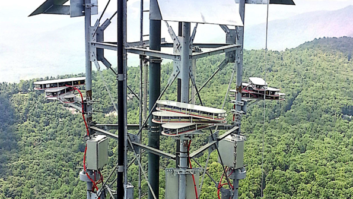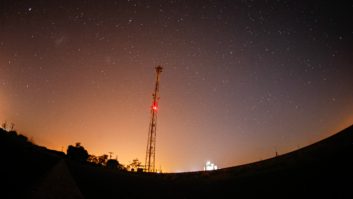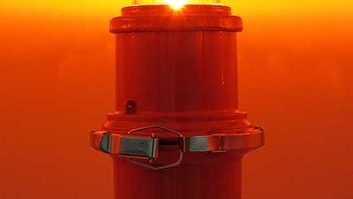LED Obstruction Lighting Systems Give Back
Jan 27, 2011 1:32 PM, By Michael Schratz
When considering all the many lighting applications that require a simple lamp change, the top of a wireless telecommunications or antenna tower stands out as one you may prefer to avoid. However, the extreme repercussions for a failed obstruction lighting system constantly haunt tower owners as they have civil responsibilities to warn pilots in order to avoid aeronautical accidents. With years of incandescent lamp failures, and the possibility of a future ban of this aging and energy-hungry lighting technology, tower owners are faced with expensive decisions to make.
Regulations set forth by the Federal Aviation Administration (FAA) force tower owners to modernize outdated lighting systems comprised of older technology such as incandescent bulbs and xenon tubes. The fines associated with light failures and the inherent safety risks involved outweigh the cost of maintaining existing lighting systems. If a tower owner has repeated failures and a history of non-compliance, the fines can sometimes be five times higher than those for the first-time offender.
Some may not realize that there has been a viable lighting alternative for marking aviation obstructions for almost ten years. Light emitting diodes, or LEDs, are the technology behind modern aviation obstruction lighting systems. For years, LEDs have been utilized in rugged applications such as traffic and railroad signals, where a failure can be catastrophic. Approximately 70 percent of traffic signals in the United States have been upgraded to LEDs as mandated by the Energy Policy Act of 2005 as the only technology approved for cities and municipalities to legally purchase moving forward.
LEDs are semiconductors which are solid-state devices that require little power, generate little heat and do not rely on a fragile filament for illumination. They are resistant to shock and vibration, contain no mercury or harmful materials, allow for precise optical control, handle extreme climates very well and most importantly, last a very long time.
The common misconception with LED systems is that the cost outweighs the benefits, and that these systems are too expensive. While the upfront cost of a new LED system may seem expensive, the actual lighting system hardware is only part of the cost equation. Taking into consideration scheduled tower climbs, energy consumption, emergency repairs, replacement lamp costs and painting, LED lighting systems typically pay for themselves in as little as two to four years. Still, only 5 percent of the industry has made the switch to an all-LED system.
Current trends in the market
Tower owners nationwide are beginning to migrate away from type-A painted towers (which only require L-864 red lighting at night) toward type-C, D, E or F non-painted towers, which replace the “candy cane” paint style with an L-864/L-865 dual red/white lighting system for either night or day use. Since the introduction of an all-LED L-864/L-865 dual red/white system in 2007, mass deployment has begun with some of the larger tower companies having made commitments to install only these systems going forward.
Prior to a legislative ban, towers primarily used lead-based paint for visual markings during the day. Now, tower owners are facing significant challenges for existing towers with this paint type. For environmental purposes, repainting a tower previously marked with lead paint means the added responsibility of ensuring that not one flake of paint chipped away touches the environment. Faced with the potential of re-painting the tower every 5 to 7 years, tower owners can expect to spend a whopping $20,000 for each of these environmentally-friendly facelifts., Meanwhile, an LED system will operate as expected throughout this time period, with no added maintenance costs. In these situations, a dual L-864/L-865 LED system may be deployed to establish compliance, the old paint may remain on the tower and the payback period for an LED system becomes even more attractive.
The cost of unreliable lighting technology
The repercussions for a failed obstruction lighting system can be quite costly, in some cases reaching $25,000 in fines. The FAA requires that a light failure be reported immediately so that a “NOTAM” (Notice to Airmen) can be issued advising aircrafts of the outage and location. The FAA routinely alerts Federal Communications Commission (FCC) field offices when tower owners fail to report that lighting outages have been repaired within the 15 day NOTAM window. Recent decisions by the FCC’s Enforcement Bureau state that failures for even a single day of non-operational tower lights will result in a fine.
Between January 2008 and August 2010, there have been 27 fines imposed for failed lighting systems, improper monitoring of lighting systems and/or improperly painted towers, resulting in nearly $300,000 in fines — all of which could have been avoided with a reliable LED lighting system. (See www.fcc.gov/eb/broadcast/asml.html)
— continued on page 2
LED Obstruction Lighting Systems Give Back
Jan 27, 2011 1:32 PM, By Michael Schratz
Long life
LEDs will last a long time, but only if the product design is engineered correctly. The key is to manage heat dissipation: keep the LEDs running cool and they will last for years. Unlike other lighting technologies, LEDs love cold weather. Most LED-based obstruction lighting systems ship with a standard five-year warranty, but most often last upwards of 10. Since the LED is semiconductor technology, they can be managed easily, networked with GPS, making the monitoring of units quite simple.
Compared to wasteful L-864 incandescent beacons that consume 1400 watts, the latest LED beacon equivalent consumes only 20 watts, or roughly 98 percent less energy. L-864/L-865 Xenon dual beacon systems consume up to 390 watts for day mode (white), and 490 watts for night mode (red). This is reduced with an LED system to 90 watts for day mode and 35 watts for night mode. Meanwhile, the L-810 side marker lights reduce consumption from 116 watts to 8.5 watts.
With recent efficiency improvements for both red and white LED technology, the products are becoming significantly smaller, which means a significant reduction in wind load. For example, the recently introduced Dialight Vigilant Series L-864/L-865 LED red/white dual beacon stands at only 7″, where the typical xenon/incandescent units installed in field are roughly 28″.

Dialight’s latest Vigilant Series LED L-864/L-865 LED dual red/white beacon is 75 percent smaller, 10 lbs. lighter and up to 95 percent more energy efficient than traditional Xenon-based dual beacons.

Dialight’s progression of LED technology from 2001 to present with LED L-864 red beacons. With the improvements of red LEDs over the years, the product size has been reduced by more than half and energy consumption has dropped from 200 watts to 20 watts to help tower owners justify the payback.
The future of the technology
High-brightness white LED technology has grown by leaps and bounds over the past few years, but the industry is on the cusp of something extraordinary. The most efficient LED on the market today is 130 lumens per watt, but recent announcements suggest that in 2011, 160 lumens per watt LEDs will be commercially available. So what does that mean for tower owners and LED obstruction lighting?
The current state of LED product development makes this technology available only for certain towers, leaving non-painted towers above 500′ unable to reap the same benefits. However, with the recent improvements in LED lighting technology, an L-856 high-intensity lighting system is almost a reality. Towers utilizing this type of lighting system can soar up to 2200′ — a very difficult height to reach to change a lamp.
— continued on page 3
LED Obstruction Lighting Systems Give Back
Jan 27, 2011 1:32 PM, By Michael Schratz
FAA Tower Lighting Requirements

Typical A1 Tower
(150′ – 300′, painted)
Lighting Requirements:
- (1) L-864 red beacon, 50 percent “on” time
- (2) or (3) L-810 red side marker lights, 50 percent “on” time
Payback analysis: Existing System Annual Maintenance Costs$895 Total Annual Energy Savings ($)$820 Total Annual Maintenance and Energy Savings$1,715 Total LED System Upgrade Costs$2,870 Payback2 years
Typical A2 Tower
(351′-700′, painted)Lighting Requirements:
- (3) L-864 red beacon, 50 percent “on” time
- (6) L-810 red side marker lights, 50 percent “on” time
Payback analysis: Existing System Annual Maintenance Costs$1,140 Total Annual Energy Savings ($)$2,305 Total Annual Maintenance and Energy Savings$3,445 Total LED System Upgrade Costs$8,040 Payback2 – 3 years
Typical D1 Tower
(200′-350′, non-painted)Lighting Requirements:
- (1) L-865 white beacon, 50 percent “on” time
Payback analysis: Existing System Annual Maintenance Costs$1,870 Total Annual Energy Savings ($)$308 Total Annual Maintenance and Energy Savings$2,178 Total LED System Upgrade Costs$6,670 Payback3 years
Typical D2 Tower
(351′-500′, non-painted)Lighting Requirements:
- (3) L-865 white beacon, 50 percent “on” time
Payback analysis: Existing System Annual Maintenance Costs$5,210 Total Annual Energy Savings ($)$925 Total Annual Maintenance and Energy Savings$6,135 Total LED System Upgrade Costs$20,000 Payback3-4 years
Typical E1 Tower
(200′-350′, non-painted)Lighting Requirements:
- (1) L-864/L-865 dual red/white beacon, 50 percent “on” time
- (2) or (3) L-810 red side marker lights, 50 percent “on” time
Payback analysis: Existing System Annual Maintenance Costs$2,177 Total Annual Energy Savings ($)$424 Total Annual Maintenance and Energy Savings$2,601 Total LED System Upgrade Costs$7,000 Payback2-3 years
Typical E2 Tower
(351′-500′, non-painted)Lighting Requirements:
- (3) L-864/L-865 dual red/white beacon, 50 percent “on” time
- (6) L-810 red side marker lights, 50 percent “on” time
Payback analysis: Existing System Annual Maintenance Costs$6,130 Total Annual Energy Savings ($)$1,106 Total Annual Maintenance and Energy Savings$7,236 Total LED System Upgrade Costs$27,000 Payback3-4 years
Notes: - All payback calculations are based on an energy rate of $0.11 kWh.
- No calculations take into consideration scheduled tower painting, which may cost upwards of $20,000 and would drive the payback down even further.
Schratz is director of marketing for Dialight Corporation.











